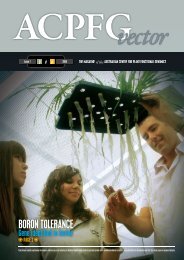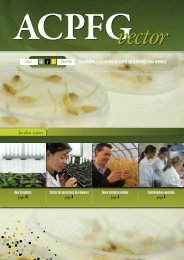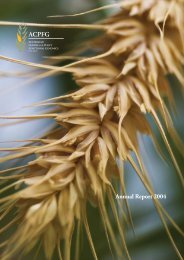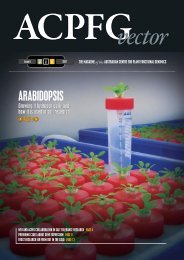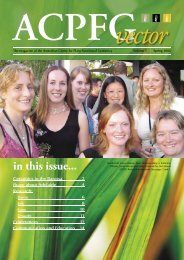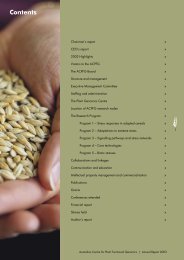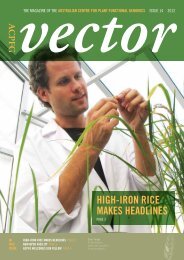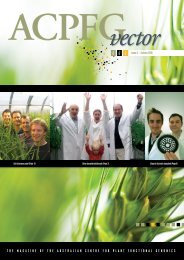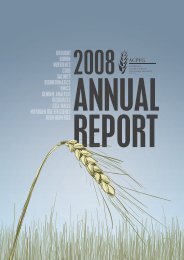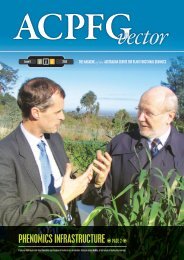ACPFG Annual Report
ACPFG Annual Report
ACPFG Annual Report
You also want an ePaper? Increase the reach of your titles
YUMPU automatically turns print PDFs into web optimized ePapers that Google loves.
<strong>ACPFG</strong> II<br />
Following the major review in 2006, a research strategy<br />
for the next five years was developed and refined during 2007.<br />
In the new research plan, further development and<br />
enhancement of technologies will continue and activities will<br />
be targeted at understanding the genetic and molecular basis<br />
of two key stresses; drought and salinity. These stresses are<br />
of fundamental importance to Australia and are predicted to<br />
grow in significance both here and overseas.<br />
The new research program has been made possible by<br />
three elements:<br />
»» <strong>ACPFG</strong>’s strong technology base;<br />
»» gene discovery work that has occurred over the past five<br />
years; and<br />
»» new national and international linkages.<br />
In devising the research strategy through to 2012 it has been<br />
necessary to consider the strengths established in <strong>ACPFG</strong>,<br />
the likely technological and resource advancements that may<br />
occur over the next five year period and the most effective<br />
methods for smoothly integrating <strong>ACPFG</strong> into broader aspects<br />
of Australian cereals research and the extensive international<br />
programs underway or in development.<br />
Funding requests were made in 2007 to the ARC, GRDC and<br />
SA Government and there were negotiations with UA, UM,<br />
UQ, Vic DPI and UniSA. Shareholders and the ARC have now<br />
committed $36.6m in cash funding to <strong>ACPFG</strong> II and a further<br />
notional in-kind contribution of $45.6m. A total of $82m has<br />
therefore been committed.<br />
A key component of <strong>ACPFG</strong>’s role includes fundamental<br />
scientific research of the highest international quality.<br />
Relatively long-term and flexible funding has enabled<br />
<strong>ACPFG</strong> to tackle difficult scientific problems such as the<br />
highly complex genetic, biochemical and physiological<br />
basis for tolerance to drought and salinity. The strength of<br />
the fundamental research, as measured for example by<br />
publications, will underpin our ability to understand and<br />
define complex biological systems and processes and will<br />
<strong>ACPFG</strong> II Cash Funding<br />
2008 2009 2010 2011 2012 TOTAL<br />
ARC* $2,223,986 $2,223,986 $2,313,835 $2,360,112 $2,407,314<br />
GRDC $2,000,000 $2,000,000 $2,000,000 $2,000,000 $2,000,000<br />
SA $1,750,000 $1,772,000 $1,816,500 $1,862,000 $1,908,500<br />
UA $1,000,000 $1,000,000 $1,000,000 $1,000,000 $1,000,000<br />
UM $150,000 $150,000 $150,000 $150,000 $150,000<br />
UQ $50,000 $50,000 $50,000 $50,000 $50,000<br />
UniSA $300,000 $300,000 $300,000 $300,000 $300,000<br />
$7,473,986 $7,495,986 $7,630,335 $7,722,112 $7,815,814 $38,138,233<br />
remain essential for the development of strategies to enhance<br />
tolerance in Australian cereals to the ravages of drought and<br />
rising salinity.<br />
The establishment of clear delivery paths for the outcomes<br />
of genomics research will become a major activity during<br />
the next five years. While the processes for delivery of<br />
conventional germplasm and molecular markers are well<br />
established in Australia, the pathway for delivery of genetically<br />
modified wheat and barley has yet to be developed. <strong>ACPFG</strong><br />
will continue to exploit those traditional delivery paths for<br />
markers that arise from the gene discovery programs. In all<br />
cases, the highest priority for <strong>ACPFG</strong> will be to ensure rapid<br />
and broad adoption of emerging technologies in Australia.<br />
Opportunities for revenue generation will be explored,<br />
particularly in overseas markets, but will be secondary to the<br />
delivery of benefits to the Australian cereal industry.<br />
<strong>ACPFG</strong> has established the commercial contacts necessary<br />
to ensure “freedom to operate” and has been developing<br />
strategies and options for the delivery of enhanced cereal<br />
varieties to Australian producers. These will now be<br />
implemented and fully tested.<br />
The strategic plan envisages the first GM field trials will be<br />
conducted in 2008 and applications have been made to the<br />
OGTR for these. Although these early trials will be largely<br />
directed at establishing systems and processes needed to<br />
manage such trials, it is planned to have barley and wheat<br />
engineered for enhanced tolerance to salt, boron and grain<br />
quality in trials in 2009, with trials of lines with enhanced<br />
drought and frost tolerance planned for 2010.<br />
<strong>ACPFG</strong> will continue to expand its education and community<br />
programs. The “Get into Genes” and “Gene Juice Bar”<br />
programs, run with the Molecular Plant Breeding CRC, are<br />
currently delivered in South Australia and Victoria. Expansion<br />
into Queensland and Western Australia is planned over the<br />
next two years. An ambitious target<br />
envisages that by 2012 over half of the<br />
senior biology students at secondary<br />
schools in the states concerned<br />
will have attended these programs.<br />
Postgraduate training will be extended<br />
through a new masters program at<br />
Adelaide, taught largely by <strong>ACPFG</strong><br />
staff. PhD student numbers will be<br />
held at around 30.<br />
*Assumes indexing at 2%<br />
10 2007 <strong>ACPFG</strong> ANNUAL REPORT



